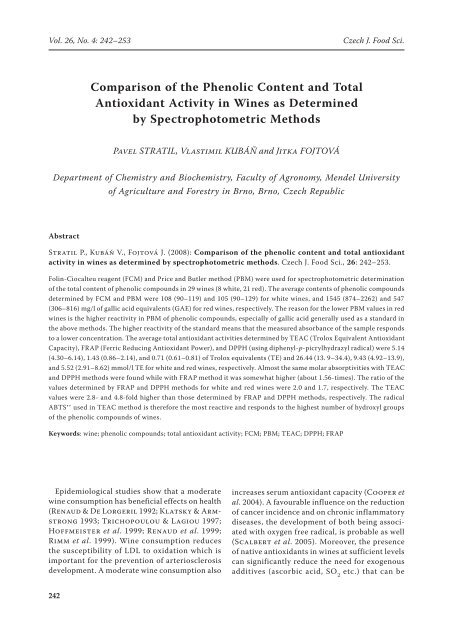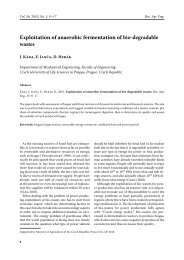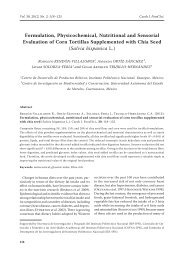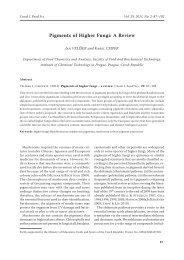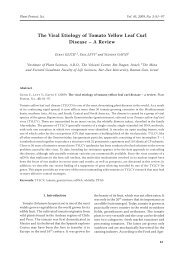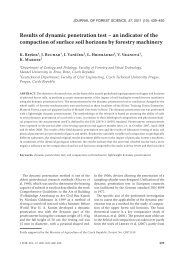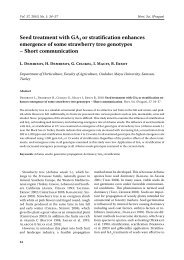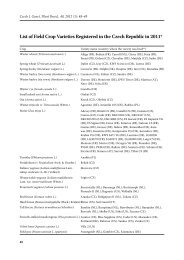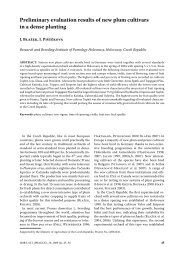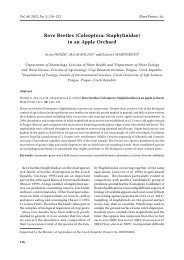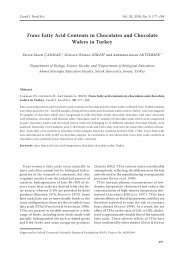Comparison of the Phenolic Content and Total Antioxidant Activity in ...
Comparison of the Phenolic Content and Total Antioxidant Activity in ...
Comparison of the Phenolic Content and Total Antioxidant Activity in ...
You also want an ePaper? Increase the reach of your titles
YUMPU automatically turns print PDFs into web optimized ePapers that Google loves.
Vol. 26, No. 4: 242–253 Czech J. Food Sci.<br />
242<br />
<strong>Comparison</strong> <strong>of</strong> <strong>the</strong> <strong>Phenolic</strong> <strong>Content</strong> <strong>and</strong> <strong>Total</strong><br />
<strong>Antioxidant</strong> <strong>Activity</strong> <strong>in</strong> W<strong>in</strong>es as Determ<strong>in</strong>ed<br />
by Spectrophotometric Methods<br />
Pavel STRATIL, Vlastimil KUBÁŇ <strong>and</strong> Jitka FOJTOVÁ<br />
Department <strong>of</strong> Chemistry <strong>and</strong> Biochemistry, Faculty <strong>of</strong> Agronomy, Mendel University<br />
Abstract<br />
<strong>of</strong> Agriculture <strong>and</strong> Forestry <strong>in</strong> Brno, Brno, Czech Republic<br />
Stratil P., Kubáň V., Fojtová J. (2008): <strong>Comparison</strong> <strong>of</strong> <strong>the</strong> phenolic content <strong>and</strong> total antioxidant<br />
activity <strong>in</strong> w<strong>in</strong>es as determ<strong>in</strong>ed by spectrophotometric methods. Czech J. Food Sci., 26: 242–253.<br />
Fol<strong>in</strong>-Ciocalteu reagent (FCM) <strong>and</strong> Price <strong>and</strong> Butler method (PBM) were used for spectrophotometric determ<strong>in</strong>ation<br />
<strong>of</strong> <strong>the</strong> total content <strong>of</strong> phenolic compounds <strong>in</strong> 29 w<strong>in</strong>es (8 white, 21 red). The average contents <strong>of</strong> phenolic compounds<br />
determ<strong>in</strong>ed by FCM <strong>and</strong> PBM were 108 (90–119) <strong>and</strong> 105 (90–129) for white w<strong>in</strong>es, <strong>and</strong> 1545 (874–2262) <strong>and</strong> 547<br />
(306–816) mg/l <strong>of</strong> gallic acid equivalents (GAE) for red w<strong>in</strong>es, respectively. The reason for <strong>the</strong> lower PBM values <strong>in</strong> red<br />
w<strong>in</strong>es is <strong>the</strong> higher reactivity <strong>in</strong> PBM <strong>of</strong> phenolic compounds, especially <strong>of</strong> gallic acid generally used as a st<strong>and</strong>ard <strong>in</strong><br />
<strong>the</strong> above methods. The higher reactivity <strong>of</strong> <strong>the</strong> st<strong>and</strong>ard means that <strong>the</strong> measured absorbance <strong>of</strong> <strong>the</strong> sample responds<br />
to a lower concentration. The average total antioxidant activities determ<strong>in</strong>ed by TEAC (Trolox Equivalent <strong>Antioxidant</strong><br />
Capacity), FRAP (Ferric Reduc<strong>in</strong>g <strong>Antioxidant</strong> Power), <strong>and</strong> DPPH (us<strong>in</strong>g diphenyl-p-picrylhydrazyl radical) were 5.14<br />
(4.30–6.14), 1.43 (0.86–2.14), <strong>and</strong> 0.71 (0.61–0.81) <strong>of</strong> Trolox equivalents (TE) <strong>and</strong> 26.44 (13. 9–34.4), 9.43 (4.92–13.9),<br />
<strong>and</strong> 5.52 (2.91–8.62) mmol/l TE for white <strong>and</strong> red w<strong>in</strong>es, respectively. Almost <strong>the</strong> same molar absorptivities with TEAC<br />
<strong>and</strong> DPPH methods were found while with FRAP method it was somewhat higher (about 1.56-times). The ratio <strong>of</strong> <strong>the</strong><br />
values determ<strong>in</strong>ed by FRAP <strong>and</strong> DPPH methods for white <strong>and</strong> red w<strong>in</strong>es were 2.0 <strong>and</strong> 1.7, respectively. The TEAC<br />
values were 2.8- <strong>and</strong> 4.8-fold higher than those determ<strong>in</strong>ed by FRAP <strong>and</strong> DPPH methods, respectively. The radical<br />
ABTS •+ used <strong>in</strong> TEAC method is <strong>the</strong>refore <strong>the</strong> most reactive <strong>and</strong> responds to <strong>the</strong> highest number <strong>of</strong> hydroxyl groups<br />
<strong>of</strong> <strong>the</strong> phenolic compounds <strong>of</strong> w<strong>in</strong>es.<br />
Keywords: w<strong>in</strong>e; phenolic compounds; total antioxidant activity; FCM; PBM; TEAC; DPPH; FRAP<br />
Epidemiological studies show that a moderate<br />
w<strong>in</strong>e consumption has beneficial effects on health<br />
(Renaud & De Lorgeril 1992; Klatsky & Armstrong<br />
1993; Trichopoulou & Lagiou 1997;<br />
H<strong>of</strong>fmeister et al. 1999; Renaud et al. 1999;<br />
Rimm et al. 1999). W<strong>in</strong>e consumption reduces<br />
<strong>the</strong> susceptibility <strong>of</strong> LDL to oxidation which is<br />
important for <strong>the</strong> prevention <strong>of</strong> arteriosclerosis<br />
development. A moderate w<strong>in</strong>e consumption also<br />
<strong>in</strong>creases serum antioxidant capacity (Cooper et<br />
al. 2004). A favourable <strong>in</strong>fluence on <strong>the</strong> reduction<br />
<strong>of</strong> cancer <strong>in</strong>cidence <strong>and</strong> on chronic <strong>in</strong>flammatory<br />
diseases, <strong>the</strong> development <strong>of</strong> both be<strong>in</strong>g associated<br />
with oxygen free radical, is probable as well<br />
(Scalbert et al. 2005). Moreover, <strong>the</strong> presence<br />
<strong>of</strong> native antioxidants <strong>in</strong> w<strong>in</strong>es at sufficient levels<br />
can significantly reduce <strong>the</strong> need for exogenous<br />
additives (ascorbic acid, SO 2 etc.) that can be
Czech J. Food Sci. Vol. 26, No. 4: 242–253<br />
l<strong>in</strong>ked to allergic effects occurr<strong>in</strong>g dur<strong>in</strong>g w<strong>in</strong>e<br />
consumption <strong>in</strong> more than 15% consumers.<br />
The more remarkable health promot<strong>in</strong>g effect <strong>of</strong><br />
w<strong>in</strong>e <strong>in</strong> comparison to alcohol alone (<strong>in</strong> addition<br />
to o<strong>the</strong>r factors) is due to <strong>the</strong> biologically active<br />
compounds, present especially <strong>in</strong> red w<strong>in</strong>e (so<br />
called French paradox). Among alcoholic beverages,<br />
red w<strong>in</strong>e has been reported to be more protective<br />
aga<strong>in</strong>st coronary heart disease than o<strong>the</strong>r alcoholic<br />
beverages (Gronbaek et al. 1995). Different w<strong>in</strong>es<br />
have different quantities <strong>and</strong> spectra <strong>of</strong> native<br />
antioxidants <strong>and</strong> <strong>the</strong>refore different health benefits.<br />
W<strong>in</strong>e composition, <strong>in</strong>clud<strong>in</strong>g <strong>the</strong> contents<br />
<strong>of</strong> phenolic compounds, varies markedly depend<strong>in</strong>g<br />
on <strong>the</strong> grape cultivar, soil, nutrition, climatic<br />
conditions, wea<strong>the</strong>r, w<strong>in</strong>emak<strong>in</strong>g procedure, <strong>and</strong><br />
conditions <strong>of</strong> maturation <strong>and</strong> storage.<br />
Over 500 different compounds, <strong>of</strong> which 160 are<br />
esters, have been identified <strong>in</strong> different w<strong>in</strong>e types.<br />
These <strong>in</strong>clude water (74–87%, w/w), ethanol<br />
(10–14%), saccharides (0.05–10%), organic acids<br />
(0.05–0.7%), phenols (0.01–0.2%), <strong>and</strong> glycerol<br />
(Soleas et al. 1997). <strong>Phenolic</strong> compounds have<br />
long been considered to be basic components<br />
<strong>of</strong> w<strong>in</strong>es <strong>and</strong> over 200 compounds have been<br />
identified. The concentration <strong>of</strong> total phenolic<br />
compounds <strong>in</strong> commercially available red w<strong>in</strong>es<br />
is rarely above 2.5 g/l (S<strong>in</strong>gleton 1982). Two<br />
primary classes <strong>of</strong> phenolics that occur <strong>in</strong> grapes<br />
<strong>and</strong> w<strong>in</strong>e are flavonoids <strong>and</strong> nonflavonoids.<br />
Flavonoids commonly constitute > 85% <strong>of</strong> <strong>the</strong><br />
phenolics content (≥ 1 g/l) <strong>in</strong> red w<strong>in</strong>es. In white<br />
w<strong>in</strong>es, flavonoids typically comprise < 20% <strong>of</strong> <strong>the</strong><br />
total phenolics content (≤ 50 mg/l). Their dietary<br />
<strong>in</strong>take has been shown to be <strong>in</strong>versely related to<br />
coronary heart disease mortality (Hertog et al.<br />
1993, 1995; Knekt et al. 1996).<br />
The most common flavonoids <strong>in</strong> white <strong>and</strong> red<br />
w<strong>in</strong>es are flavonols, catech<strong>in</strong>s (flavan-3-ols), <strong>and</strong><br />
anthocyanid<strong>in</strong>s, <strong>the</strong> latter be<strong>in</strong>g found only <strong>in</strong> red<br />
w<strong>in</strong>e. Small amounts <strong>of</strong> free leucoanthocyan<strong>in</strong>s (flavan-3,4-diols)<br />
also occur. Flavonoids exist free or<br />
bound to o<strong>the</strong>r flavonoids, sugars, nonflavonoids,<br />
or comb<strong>in</strong>ations <strong>of</strong> <strong>the</strong>se compounds. Flavonols<br />
<strong>and</strong> anthocyanid<strong>in</strong>s orig<strong>in</strong>ate predom<strong>in</strong>ately from<br />
<strong>the</strong> sk<strong>in</strong>, whereas catech<strong>in</strong>s <strong>and</strong> leucoanthocyan<strong>in</strong>s<br />
orig<strong>in</strong>ate ma<strong>in</strong>ly from <strong>the</strong> seeds <strong>and</strong> stems. Nonflavonoids<br />
partly orig<strong>in</strong>ate also from yeast <strong>and</strong> <strong>the</strong><br />
wood <strong>of</strong> oak barrels (Soleas et al. 1997).<br />
The phenolic composition <strong>and</strong> <strong>the</strong> extractability<br />
<strong>of</strong> grapes largely depend on <strong>the</strong> grape variety<br />
<strong>and</strong> <strong>the</strong> w<strong>in</strong>emak<strong>in</strong>g process conditions (Soleas<br />
et al. 1997). The amount <strong>of</strong> flavonoids extracted<br />
dur<strong>in</strong>g v<strong>in</strong>ification is <strong>in</strong>fluenced by many factors,<br />
<strong>in</strong>clud<strong>in</strong>g temperature, mix<strong>in</strong>g, <strong>the</strong> parameters<br />
<strong>of</strong> <strong>the</strong> fermentation vessel, <strong>the</strong> duration <strong>of</strong> sk<strong>in</strong><br />
maceration, ethanol concentration, SO 2 , yeast<br />
stra<strong>in</strong>, pH, <strong>and</strong> pectolytic enzymes. The concentration<br />
<strong>of</strong> phenolic compounds <strong>in</strong> w<strong>in</strong>e <strong>in</strong>creases<br />
dur<strong>in</strong>g sk<strong>in</strong> fermentation <strong>and</strong> subsequently beg<strong>in</strong>s<br />
to decrease as phenols b<strong>in</strong>d with prote<strong>in</strong>s <strong>and</strong><br />
yeast hulls (cell remnants), <strong>and</strong> precipitate. Dur<strong>in</strong>g<br />
f<strong>in</strong><strong>in</strong>g <strong>and</strong> maturation, <strong>the</strong> concentration <strong>of</strong><br />
phenolic compounds cont<strong>in</strong>ues to decrease. Their<br />
concentration is fur<strong>the</strong>r substantially decreased<br />
at ag<strong>in</strong>g.<br />
Ag<strong>in</strong>g <strong>in</strong> oak-wood barrels (barrique w<strong>in</strong>es) can<br />
also <strong>in</strong>crease <strong>the</strong> contents <strong>of</strong> particular phenolic<br />
compounds (Matějíček et al. 2005). Some phenols<br />
<strong>in</strong> w<strong>in</strong>e arise by <strong>the</strong> activity <strong>of</strong> micro-organisms<br />
as secondary aromatic compounds <strong>in</strong> <strong>the</strong><br />
course <strong>of</strong> <strong>the</strong> degradation <strong>of</strong> phenolic acids or<br />
lign<strong>in</strong> as well. They arise as by-products <strong>of</strong> lactic<br />
<strong>and</strong> alcoholic fermentations. Such a compound is<br />
e.g. ferulylalcohol (or 4-v<strong>in</strong>ylguajacol) <strong>and</strong> o<strong>the</strong>r<br />
similar alcohols.<br />
The taste <strong>and</strong> o<strong>the</strong>r sensory characteristics are<br />
primarily due to a few compounds that occur<br />
<strong>in</strong>dividually at concentrations above 100 mg/l.<br />
Lower phenolic acids account for flat flavour<br />
while larger polyphenols contribute to bitterness<br />
<strong>and</strong> astr<strong>in</strong>gency. Tann<strong>in</strong>s present <strong>in</strong> red w<strong>in</strong>e<br />
are rarely found <strong>in</strong> white w<strong>in</strong>es <strong>in</strong> significant<br />
amounts.<br />
Literature data about <strong>the</strong> contents <strong>of</strong> phenolic<br />
compounds <strong>and</strong> total antioxidant activity are <strong>in</strong>sufficient<br />
<strong>and</strong> partly contradictory. This is due not only<br />
to different contents <strong>and</strong> proportions <strong>of</strong> particular<br />
phenolic compounds <strong>in</strong> different sorts <strong>of</strong> w<strong>in</strong>es,<br />
but above all to different methods <strong>and</strong> various<br />
methodological approaches used. The comparison<br />
<strong>of</strong> <strong>the</strong> literature data is thus very complicated <strong>and</strong><br />
even impossible <strong>in</strong> some cases.<br />
In <strong>the</strong> present paper we applied FCM <strong>and</strong> PBM<br />
methods for <strong>the</strong> determ<strong>in</strong>ation <strong>of</strong> <strong>the</strong> total contents<br />
<strong>of</strong> phenolic compounds, <strong>and</strong> TEAC, FRAP,<br />
<strong>and</strong> DPPH methods for <strong>the</strong> determ<strong>in</strong>ation <strong>of</strong> total<br />
antioxidant activity <strong>in</strong> 29 w<strong>in</strong>es. Ano<strong>the</strong>r aim <strong>of</strong><br />
<strong>the</strong> paper was to describe <strong>the</strong> basic pr<strong>in</strong>ciples<br />
applicable for <strong>the</strong> comparison <strong>of</strong> <strong>the</strong> values determ<strong>in</strong>ed<br />
with those published <strong>in</strong> literature, <strong>and</strong> to<br />
compare <strong>the</strong> sale prices with <strong>the</strong> quality <strong>of</strong> w<strong>in</strong>es<br />
expressed by <strong>the</strong> content <strong>of</strong> phenolic compounds<br />
<strong>and</strong> antioxidant activity.<br />
243
Vol. 26, No. 4: 242–253 Czech J. Food Sci.<br />
244<br />
MATERIAL AND METHODS<br />
Chemicals. 2,2-diphenyl-1-picrylhydrazyl radical<br />
(DPPH • , ≈ 90.0%) <strong>and</strong> 2,2´-az<strong>in</strong>obis(3- ethylbenzothiazol<strong>in</strong>-6-sulfonate)<br />
diammonium salts (ABTS,<br />
≈ 98.0%) were purchased from Sigma-Aldrich (St.<br />
Louis, USA); Fol<strong>in</strong>-Ciocalteu reagent (FC reagent),<br />
2,4,6-tris(2-pyridyl)-s-triaz<strong>in</strong>e (TPTZ, puriss,<br />
≥ 99.0%), gallic acid monohydrate (≥ 98.0%), <strong>and</strong><br />
Trolox (6-hydroxy-2,5,7,8-tetramethylchromane-<br />
2-carboxylic acid, a hydrophilic derivative <strong>of</strong> tocopherol,<br />
purum, ≥ 99%, for HPLC), were from Fluka<br />
(Buchs, Switzerl<strong>and</strong>). Methanol <strong>and</strong> acetonitrile<br />
<strong>of</strong> gradient grade were purchased from Merck<br />
(Darmstadt, Germany). O<strong>the</strong>r chemicals <strong>of</strong> p.a.<br />
purity were from Pliva-Lachema (Brno, Czech<br />
Republic). All reagents <strong>and</strong> st<strong>and</strong>ard solutions<br />
were prepared us<strong>in</strong>g deionised reverse osmosis<br />
water (AquaDem-2, Aqua Osmotic, Tišnov, Czech<br />
Republic) fur<strong>the</strong>r purified by Milli Q-RG (Millipore,<br />
Bedford, USA) apparatus.<br />
Sample preparation. Samples <strong>of</strong> 29 species<br />
<strong>of</strong> w<strong>in</strong>es (8 white, <strong>and</strong> 21 red) produced <strong>in</strong> <strong>the</strong><br />
Czech Republic or imported <strong>in</strong> <strong>the</strong> year 2006 were<br />
obta<strong>in</strong>ed from private cellars or purchased from<br />
local stores (Table 1). The w<strong>in</strong>es were used directly<br />
from bottles or barrels. The samples <strong>of</strong> w<strong>in</strong>es were<br />
stored at 5–8°C <strong>in</strong> dark until analysed. Each w<strong>in</strong>e<br />
was analysed three times.<br />
Determ<strong>in</strong>ation <strong>of</strong> phenolic compounds <strong>in</strong> w<strong>in</strong>es.<br />
Fol<strong>in</strong>-Ciocalteu method. FCM based on <strong>the</strong> reduction<br />
<strong>of</strong> a phosphotungstate-phosphomolybdate<br />
complex by phenolic compounds to blue reaction<br />
products was used (Wildenradt & S<strong>in</strong>gleton<br />
1974; V<strong>in</strong>son et al. 1998; S<strong>in</strong>gleton et al. 1999).<br />
The total volume <strong>of</strong> <strong>the</strong> reaction mixture was m<strong>in</strong>imised<br />
to 1 ml. Each sample (white w<strong>in</strong>es 100 μl,<br />
red w<strong>in</strong>es 50–100 μl diluted 10-fold) was read at<br />
760 nm after 30 m<strong>in</strong> <strong>of</strong> st<strong>and</strong><strong>in</strong>g aga<strong>in</strong>st blank<br />
(100 μl water <strong>in</strong>stead <strong>of</strong> sample). Five-po<strong>in</strong>t calibration<br />
us<strong>in</strong>g 2 mmol/l gallic acid as <strong>the</strong> st<strong>and</strong>ard<br />
was l<strong>in</strong>ear (R 2 > 0.997) up to <strong>the</strong> concentration <strong>of</strong><br />
0.2 mmol/l <strong>in</strong> <strong>the</strong> reaction mixture <strong>and</strong> <strong>the</strong> absorbance<br />
range up to 3.000 AU. The determ<strong>in</strong>ed<br />
values were expressed as gallic acid equivalents<br />
(GAE). Highly repeatable results for st<strong>and</strong>ards<br />
<strong>and</strong> samples were obta<strong>in</strong>ed.<br />
Method accord<strong>in</strong>g Price <strong>and</strong> Butler (1977).<br />
In this method, phenolate anion is oxidised to<br />
phenolate radical <strong>and</strong> at <strong>the</strong> same time hexacyan<strong>of</strong>errite<br />
(ferricyanide) ion is reduced to hexacyan<strong>of</strong>errate<br />
(ferrocyanide) form<strong>in</strong>g Prussian blue<br />
(III)) (II) K (Fe [Fe (CN)6 ] )(Huang et al. 2005) ac-<br />
x n<br />
3<br />
cord<strong>in</strong>g to <strong>the</strong> equation:<br />
K [Fe 3 (III) (CN) ] + Ph-OH →<br />
6<br />
(III) K (Fe x n<br />
[Fe(II) (CN) 6 ] 3 ) + Ph-O • + H +<br />
The Waterman <strong>and</strong> Mole’s procedure (Waterman<br />
& Mole 1994) was modified to a semi micro-scale<br />
(reaction volume 1 ml). The samples <strong>of</strong><br />
w<strong>in</strong>es (25 μl) <strong>of</strong> 2- <strong>and</strong> 10-fold diluted white <strong>and</strong><br />
red w<strong>in</strong>es, respectively, were mixed with 750 μl<br />
<strong>of</strong> deionised water <strong>and</strong> 100 μl 0.1 mol/l FeCl 3<br />
<strong>in</strong> 0.1 mol/l HCl. After 3 m<strong>in</strong> st<strong>and</strong><strong>in</strong>g, 100 μl<br />
8 mmol/l potassium ferricyanide was added <strong>and</strong><br />
<strong>the</strong> volume was adjusted to 1000 μl with deionised<br />
water <strong>and</strong> mixed. The reaction reached <strong>the</strong> maximum<br />
between 20 <strong>and</strong> 30 m<strong>in</strong>utes. Colour (green to<br />
blue) was measured aga<strong>in</strong>st blank (water <strong>in</strong>stead<br />
<strong>of</strong> sample) at 720 nm after 30 m<strong>in</strong>utes. Gallic acid<br />
(0.5 mmol/l) was applied as <strong>the</strong> st<strong>and</strong>ard <strong>and</strong> <strong>the</strong><br />
values were expressed as gallic acid equivalents<br />
(GAE).<br />
Determ<strong>in</strong>ation <strong>of</strong> antioxidant activity/capacity<br />
<strong>of</strong> w<strong>in</strong>es. Three methods, TEAC, FRAP,<br />
<strong>and</strong> DPPH • , based on <strong>the</strong> reaction with electron<br />
donat<strong>in</strong>g or hydrogen radicals (H • ) produc<strong>in</strong>g<br />
compounds/antioxidants accord<strong>in</strong>g to <strong>the</strong> follow<strong>in</strong>g<br />
reaction were used:<br />
R • + Aox-H → RH + Aox •<br />
where:<br />
R • = DPPH • , ABTS •+ or o<strong>the</strong>r reactive radical<br />
Aox-H = Ph-OH, Trolox, ascorbic acid, etc.<br />
Ph = polyphenolic compound<br />
Despite <strong>the</strong> similar mechanisms <strong>of</strong> <strong>the</strong> methods,<br />
<strong>the</strong> reagents <strong>and</strong> products are different. Trolox was<br />
used as a common st<strong>and</strong>ard for <strong>the</strong> calibration <strong>of</strong><br />
<strong>the</strong> methods, which makes <strong>the</strong> comparison <strong>of</strong> <strong>the</strong><br />
measured values easier. The values <strong>of</strong> all three<br />
methods were expressed as a Trolox equivalent<br />
(TE).<br />
TEAC Method (Trolox Equivalent <strong>Antioxidant</strong><br />
Capacity or <strong>Total</strong> <strong>Antioxidant</strong> <strong>Activity</strong> – TAA)<br />
method (Miller et al. 1993; Rice-Evans et al.<br />
1996; Lien et al. 1999; Plumb et al. 1999). The<br />
total volume used <strong>in</strong> <strong>the</strong> orig<strong>in</strong>al procedure (Re et<br />
al. 1999; Long & Halliwell 2001) was reduced<br />
to 1 ml. The stock solution, a 1:1 (v/v) mixture<br />
<strong>of</strong> ABTS (7 mmol/l) <strong>and</strong> potassium persulfate<br />
(4.95 mmol/l), was left to st<strong>and</strong> for 12 h at laboratory<br />
temperature <strong>in</strong> dark to form radical-cation
Czech J. Food Sci. Vol. 26, No. 4: 242–253<br />
Table 1. <strong>Content</strong> <strong>of</strong> phenolic compounds <strong>and</strong> total antioxidant activity <strong>in</strong> w<strong>in</strong>es<br />
No. 1 pH 2 EtOH 2<br />
(%)<br />
White w<strong>in</strong>es<br />
FCM 3 PBM 3 TEAC 4 FRAP 4 DPPH 4<br />
(mmol/l) 5 (mg/l) (mmol/l) 5 (mg/l) (mmol/l) 5<br />
1 3.55 12.32 0.53 ± 0.01 90 0.53 ± 0.03 90 4.30 ± 0.19 1.79 ± 0.11 0.72 ± 0.02 0<br />
2 3.42 11.16 0.61 ± 0.06 104 0.53 ± 0.04 91 4.78 ± 0.28 1.00 ± 0.02 0.63 ± 0.02 0<br />
3 3.58 12.62 0.60 ± 0.01 103 0.53 ± 0.05 90 5.13 ± 0.04 0.88 ± 0.03 0.61 ± 0.08 0<br />
4 3.51 11.96 0.63 ± 0.01 107 0.56 ± 0.00 95 5.08 ± 0.02 0.86 ± 0.02 0.66 ± 0.06 0<br />
5 3.53 11.98 0.73 ± 0.01 125 0.76 ± 0.10 129 6.14 ± 0.32 2.14 ± 0.01 0.81 ± 0.01 0<br />
6 3.54 11.53 0.65 ± 0.01 110 0.70 ± 0.01 119 5.08 ± 0.05 1.93 ± 0.03 0.73 ± 0.01 0<br />
7 3.42 12.41 0.70 ± 0.02 119 0.72 ± 0.05 122 5.57 ± 0.01 1.00 ± 0.04 0.79 ± 0.01 0<br />
8 3.57 11.54 0.97 ± 0.01 166 1.21 ± 0.01 206 8.44 ± 0.91 1.47 ± 0.01 1.78 ± 0.03 0<br />
Red w<strong>in</strong>es<br />
A 520<br />
(AU) 6<br />
9 3.49 10.50 5.66 ± 0.01 963 2.22 ± 0.01 377 17.84 ± 0.01 6.34 ± 0.01 3.70 ± 0.01 1.06<br />
10 3.56 12.06 10.17 ± 0.01 1730 3.80 ± 0.01 647 30.85 ± 0.01 5.65 ± 0.01 3.38 ± 0.01 5.21<br />
11 3.21 11.07 11.22 ± 0.01 1908 3.50 ± 0.01 595 32.30 ± 0.01 11.38 ± 0.01 7.33 ± 0.01 3.57<br />
12 3.59 13.61 5.14 ± 0.01 874 1.80 ± 0.01 306 13.89 ± 0.01 4.92 ± 0.01 2.91 ± 0.01 2.16<br />
13 3.48 12.44 7.17 ± 0.01 1219 2.60 ± 0.01 442 20.15 ± 0.01 7.41 ± 0.01 4.20 ± 0.01 2.16<br />
14 3.40 12.31 8.95 ± 0.01 1523 3.48 ± 0.01 592 25.62 ± 0.01 8.60 ± 0.01 4.77 ± 0.01 3.18<br />
15 3.45 11.70 8.41 ± 0.01 1431 3.46 ± 0.01 588 24.44 ± 0.01 9.98 ± 0.01 4.64 ± 0.01 2.68<br />
16 3.63 11.64 9.11 ± 0.01 1550 3.26 ± 0.01 554 26.36 ± 0.01 9.99 ± 0.01 5.88 ± 0.01 5.02<br />
17 3.75 12.83 11.60 ± 0.01 1973 3.46 ± 0.01 589 34.69 ± 0.01 12.41 ± 0.01 7.78 ± 0.01 4.11<br />
18 3.62 12.57 9.80 ± 0.01 1666 3.14 ± 0.01 534 28.38 ± 0.01 10.37 ± 0.01 6.21 ± 0.01 3.13<br />
19 3.54 12.67 6.19 ± 0.01 1054 2.20 ± 0.01 375 16.74 ± 0.01 6.84 ± 0.01 3.73 ± 0.01 3.53<br />
20 3.57 11.49 6.87 ± 0.01 1169 2.60 ± 0.01 443 20.50 ± 0.01 7.34 ± 0.01 4.05 ± 0.01 3.16<br />
21 3.63 11.78 7.72 ± 0.01 1314 2.65 ± 0.01 451 23.72 ± 0.01 8.62 ± 0.01 5.47 ± 0.01 2.72<br />
22 3.53 12.56 8.47 ± 0.01 1440 3.28 ± 0.01 558 25.41 ± 0.01 9.97 ± 0.01 4.48 ± 0.01 3.41<br />
23 3.69 11.37 10.78 ± 0.01 1833 3.56 ± 0.01 606 30.53 ± 0.01 11.35 ± 0.01 7.05 ± 0.01 3.17<br />
24 3.68 12.68 8.91 ± 0.01 1515 2.91 ± 0.01 496 25.26 ± 0.01 9.52 ± 0.01 5.86 ± 0.01 4.06<br />
25 3.44 11.21 10.73 ± 0.01 1825 3.93 ± 0.01 669 32.37 ± 0.01 11.56 ± 0.01 6.60 ± 0.01 8.68<br />
26 3.85 11.84 8.86 ± 0.01 1508 3.04 ± 0.01 516 25.07 ± 0.01 8.94 ± 0.01 5.51 ± 0.01 4.25<br />
27 3.45 11.32 10.66 ± 0.01 1813 3.70 ± 0.01 629 32.50 ± 0.01 11.65 ± 0.01 6.65 ± 0.01 8.13<br />
28 3.67 12.07 11.00 ± 0.01 1871 4.13 ± 0.01 703 34.38 ± 0.01 11.34 ± 0.01 7.12 ± 0.01 4.91<br />
29 3.48 – 13.30 ± 0.01 2262 4.80 ± 0.01 816 34.27 ± 0.01 13.94 ± 0.01 8.62 ± 0.01 4.01<br />
1 a b b b a 1. Ryzl<strong>in</strong>k vlašský , 2. Ryzl<strong>in</strong>k vlašský , 3. Müller-Thurgau , 4. Veltlín zelený , 5. Veltlín zelený , 6. Muscadel Moravia<br />
(MOPR) a , 7. Chardonnay, late ga<strong>the</strong>r<strong>in</strong>ga , 8. Tramín rosé, late ga<strong>the</strong>r<strong>in</strong>ga , 9. Frankovka blue-dry, Hungary, La Fiesta, area<br />
Duna Mellék, year 2004, Supermarket Billa, 10. Frankovka, Macedonia c , 11. Frankovkaa , 12. Modrý Portugalb , 13. Modrý<br />
Portugal, shop, 14. Modrý Portugalb , 15. Rul<strong>and</strong>ské modré, cellar Stráchot<strong>in</strong>c , 16. Cabernet Sauvignonb , 17. Cabernet Sauvignon,<br />
Argent<strong>in</strong>ac , 18. Cabernet Moraviaa , 19. Svatovavř<strong>in</strong>ecké b (Sa<strong>in</strong>tlaurence), 20. Svatovavř<strong>in</strong>ecké b , 21. Svatovavř<strong>in</strong>ecké,<br />
private cellar Krumvíř, 22. Svatovavř<strong>in</strong>ecké klasik, Rakvice, area Small Carpathian Mounta<strong>in</strong>s, SO added, hypermarket,<br />
2<br />
23. Svatovavř<strong>in</strong>ecké a , 24. Zweigeltrebe a , 25. Zweigeltrebe d , 26. André, private cellara , 27. André + Portugald , 28. Syrah,<br />
Argent<strong>in</strong>ac , 29. Italian red w<strong>in</strong>ec a b c private cellar from south Moravia, salesroom <strong>of</strong> w<strong>in</strong>es from south Moravia, salesroom <strong>of</strong> domestic <strong>and</strong> imported w<strong>in</strong>es,<br />
dprivate salesroom <strong>of</strong> w<strong>in</strong>es from south Moravia<br />
2 3 4 5 6 average values from three repetition, gallic acid equivalents (GAE), Trolox equivalent (TE), mean ± SD, n = 3, AU =<br />
absorbance units (absorbance × dilution)<br />
245
Vol. 26, No. 4: 242–253 Czech J. Food Sci.<br />
ABTS •+ . The f<strong>in</strong>al solution was stable for at least<br />
one week at 4°C <strong>in</strong> dark.<br />
The stock solution was diluted with phosphate<br />
buffer solution to give <strong>the</strong> absorbance values between<br />
1.0 <strong>and</strong> 1.5 AU at 734 nm (<strong>the</strong> same absorbance<br />
value must be used for <strong>the</strong> st<strong>and</strong>ard <strong>and</strong><br />
samples). The st<strong>and</strong>ard or sample (20 μl) <strong>of</strong> 4-fold<br />
<strong>and</strong> 20- or 40-fold diluted white <strong>and</strong> red w<strong>in</strong>es<br />
(accord<strong>in</strong>g to <strong>the</strong> reaction <strong>in</strong>tensity), respectively,<br />
were mixed with <strong>the</strong> work<strong>in</strong>g solution (975 μl) <strong>and</strong><br />
adjusted to 1000 μl with deionised water. The decrease<br />
<strong>of</strong> <strong>the</strong> absorbance at 734 nm was measured<br />
after 30 m<strong>in</strong> (after reach<strong>in</strong>g plateau). Aqueous<br />
phosphate buffer solution (1 ml, without ABTS •+ )<br />
<strong>and</strong> Trolox (0.5 mmol/l) were used as a control<br />
<strong>and</strong> a calibrat<strong>in</strong>g st<strong>and</strong>ard, respectively.<br />
Ferric Reduc<strong>in</strong>g <strong>Antioxidant</strong> Power (FRAP) method<br />
(Benzie & Stra<strong>in</strong> 1996; Pulido et al. 2000; Imeh<br />
& Khokhar 2002) was modified to a semi microscale<br />
us<strong>in</strong>g <strong>the</strong> total volume <strong>of</strong> 1 ml. A portion <strong>of</strong><br />
an aqueous 10 mmol/l solution <strong>of</strong> TPTZ reagent <strong>in</strong><br />
40 mmol/l HCl was mixed with <strong>the</strong> same volume<br />
<strong>of</strong> 20 mmol/l FeCl 3 ·6 H 2 O <strong>and</strong> ten times higher<br />
volume <strong>of</strong> acetate buffer <strong>of</strong> pH 3.6 (3.1 g sodium<br />
acetate <strong>and</strong> 16 ml acetic acid per litre). The mixture<br />
was <strong>in</strong>cubated at 37°C for five m<strong>in</strong>utes. A portion<br />
(900 μl) <strong>of</strong> <strong>the</strong> Fe 3+ -TPTZ mixture <strong>and</strong> <strong>the</strong> sample<br />
<strong>of</strong> w<strong>in</strong>e (25 μl; red w<strong>in</strong>es diluted 5 to 10-fold) or<br />
<strong>the</strong> st<strong>and</strong>ard or water (for blank) were adjusted<br />
to 1000 μl with deionised water, <strong>in</strong>cubated for 30<br />
m<strong>in</strong> (after reach<strong>in</strong>g plateau), <strong>and</strong> <strong>the</strong> absorbance<br />
at 593 nm was read. Trolox (0.5 mmol/l) was used<br />
for calibration (Gardner et al. 2000).<br />
Diphenyl-p-picrylhydrazyl (DPPH) method. The<br />
orig<strong>in</strong>al procedure (Sánchez-Moreno et al. 1998)<br />
was modified (to 1 ml total volume). The work<strong>in</strong>g<br />
solution was prepared by dilution <strong>of</strong> methanolic<br />
DPPH • solution (98 mg/l, absorbance ≈ 1.9) to <strong>the</strong><br />
absorbance <strong>of</strong> ≈ 1.5 AU (<strong>the</strong> same for <strong>the</strong> sample<br />
<strong>and</strong> st<strong>and</strong>ard) to provide a sufficient reaction capacity<br />
for higher contents <strong>of</strong> antioxidants <strong>in</strong> <strong>the</strong><br />
extracts. A portion (950 μl) <strong>of</strong> <strong>the</strong> work<strong>in</strong>g solution<br />
<strong>and</strong> <strong>the</strong> sample <strong>of</strong> w<strong>in</strong>es (50 μl; red w<strong>in</strong>es diluted<br />
5 to 10-fold) or st<strong>and</strong>ard were adjusted to 1000 μl<br />
with aqueous methanol (1:1, v/v) <strong>and</strong> <strong>in</strong>cubated<br />
30 m<strong>in</strong>utes to reach plateau (Kim et al. 2002).<br />
The absorbance was read at 515 nm aga<strong>in</strong>st blank<br />
(aqueous methanol). Fresh 0.5 mmol/l work<strong>in</strong>g<br />
solutions <strong>of</strong> Trolox were used for calibration.<br />
Determ<strong>in</strong>ation <strong>of</strong> ethanol. A gas chromatograph<br />
HP-4890D with a flame-ionisation detector was<br />
used for <strong>the</strong> assessment <strong>of</strong> ethanol us<strong>in</strong>g an HP-5MS<br />
246<br />
(5% Phenyl Methyl Siloxane, 30 m × 0.25 mm ×<br />
0.25 μm film) analytical column (all from Hewlett<br />
Packard, Waldbronn, Germany). The flow rate<br />
<strong>of</strong> helium was 1 ml/m<strong>in</strong>, split ratio 20:1, spray<br />
temperature 240°C, detector temperature 250°C,<br />
<strong>and</strong> <strong>the</strong>rmal programme: T 1 = 30°C, t 1 = 5 m<strong>in</strong>,<br />
40°C/m<strong>in</strong> on T 2 = 70°C, t 2 = 1 m<strong>in</strong>, ca 7 m<strong>in</strong>. The<br />
applied volume <strong>of</strong> <strong>the</strong> samples was 1 μl.<br />
Determ<strong>in</strong>ation <strong>of</strong> color <strong>in</strong>tensity. Colour <strong>in</strong>tensity<br />
<strong>of</strong> <strong>the</strong> red w<strong>in</strong>es was determ<strong>in</strong>ed spectrophotometrically<br />
at 520 nm. Optimal wavelength for<br />
measur<strong>in</strong>g was selected by scann<strong>in</strong>g full spectrum<br />
from 200 to 700 nm. All samples <strong>of</strong> w<strong>in</strong>es were<br />
diluted 5-fold before measur<strong>in</strong>g. The measured<br />
values shown <strong>in</strong> Table 1 <strong>and</strong> Figures 2 are expressed<br />
<strong>in</strong> absorbance units (AU).<br />
RESULTS AND DISCUSSION<br />
The determ<strong>in</strong>ed contents <strong>of</strong> phenolic compounds<br />
<strong>and</strong> antioxidant activity values are presented <strong>in</strong> Figures<br />
1 <strong>and</strong> 2. Both methods for <strong>the</strong> determ<strong>in</strong>ation<br />
<strong>of</strong> phenolic compounds were st<strong>and</strong>ardised us<strong>in</strong>g<br />
<strong>the</strong> same st<strong>and</strong>ard; however, <strong>the</strong> reactivity with<br />
<strong>the</strong> st<strong>and</strong>ard differed with <strong>the</strong> <strong>in</strong>dividual methods.<br />
The average values <strong>of</strong> phenolic compounds content<br />
<strong>in</strong> white w<strong>in</strong>es determ<strong>in</strong>ed by FCM were <strong>in</strong><br />
<strong>the</strong> <strong>in</strong>terval <strong>of</strong> 103–125 mg/l GAE except <strong>of</strong> one<br />
Ryzl<strong>in</strong>k vlašský (90 mg/l). The values <strong>of</strong> phenolic<br />
compounds content <strong>in</strong> red w<strong>in</strong>es were approximately<br />
10- to 15-times higher, namely from 874 to<br />
1973 mg/l, <strong>and</strong> <strong>in</strong> one Italian red w<strong>in</strong>e reached as<br />
much as 2261 mg/l. The determ<strong>in</strong>ed content <strong>of</strong><br />
phenolic compounds (166 mg/ml) was notably<br />
higher <strong>in</strong> Tram<strong>in</strong> than <strong>in</strong> o<strong>the</strong>r white w<strong>in</strong>es. Our<br />
values for white w<strong>in</strong>es were about 30 to 50% lower<br />
<strong>in</strong> comparison with <strong>the</strong> results published by three<br />
o<strong>the</strong>r authors <strong>and</strong> very close to <strong>the</strong> values published<br />
by Simonetti et al. (1997) (Table 2).<br />
The differences <strong>in</strong> <strong>the</strong> values are probably not<br />
<strong>of</strong> a methodological orig<strong>in</strong> because <strong>the</strong> most commonly<br />
used FCM for <strong>the</strong> assessment <strong>of</strong> phenolics<br />
is relatively robust <strong>and</strong> trouble-free.<br />
The differences between our values <strong>and</strong> <strong>the</strong> published<br />
results could be primarily affected by <strong>the</strong><br />
nature <strong>of</strong> <strong>the</strong> analysed w<strong>in</strong>es, i.e. by <strong>the</strong>ir actual<br />
contents <strong>of</strong> phenolic compounds. The great differences<br />
<strong>in</strong> <strong>the</strong> contents <strong>of</strong> phenolic compounds<br />
<strong>in</strong> white <strong>and</strong> red w<strong>in</strong>es <strong>in</strong>dicate that anthocyan<strong>in</strong>s<br />
form <strong>the</strong> most important part <strong>of</strong> <strong>the</strong> phenolic<br />
compounds <strong>in</strong> red w<strong>in</strong>es. Beside o<strong>the</strong>r factors, <strong>the</strong><br />
grape variety, <strong>in</strong>tensity <strong>of</strong> solar irradiation at <strong>the</strong>
Czech J. Food Sci. Vol. 26, No. 4: 242–253<br />
5.0<br />
(mmol/l)<br />
4.5<br />
4.0<br />
3.5<br />
3.0<br />
2.5<br />
2.0<br />
1.5<br />
1.0<br />
0.5<br />
0.0<br />
PCM PBM TEAC/2 FRAP DPPH<br />
1 2 3 4 5 6 7 8<br />
Figure 1. <strong>Content</strong>s <strong>of</strong> phenolic compounds <strong>of</strong> white w<strong>in</strong>es determ<strong>in</strong>ed by <strong>the</strong> FC <strong>and</strong> PB ethods (GE μmol/l), <strong>and</strong> total<br />
antioxidant activity determ<strong>in</strong>ed by <strong>the</strong> TEAC, FRAP <strong>and</strong> DPPH methods (TE mmol/l)<br />
ripen<strong>in</strong>g time <strong>of</strong> grapes, <strong>and</strong> w<strong>in</strong>emak<strong>in</strong>g procedure<br />
mostly <strong>in</strong>fluence <strong>the</strong> phenolic compounds content.<br />
Therefore, much higher contents <strong>of</strong> anthocyan<strong>in</strong>s<br />
<strong>and</strong> total contents <strong>of</strong> phenolic compounds are<br />
present especially <strong>in</strong> red w<strong>in</strong>es from sunny regions<br />
(Italy, Spa<strong>in</strong>, California etc.).<br />
The content <strong>of</strong> phenolics determ<strong>in</strong>ed by FCM <strong>and</strong><br />
PBM was approximately <strong>the</strong> same <strong>in</strong> white w<strong>in</strong>es.<br />
The values determ<strong>in</strong>ed <strong>in</strong> FCM <strong>in</strong> red w<strong>in</strong>es were<br />
2- to 3-times higher than those determ<strong>in</strong>ed by PBM<br />
for identical samples. This difference could be at<br />
least partly expla<strong>in</strong>ed by a different reactivity <strong>of</strong><br />
anthocyan<strong>in</strong>s with <strong>the</strong> reagent <strong>in</strong> <strong>the</strong> respective<br />
methods. This presumption is supported by <strong>the</strong><br />
fact that millimolar absorption coefficient <strong>of</strong> gallic<br />
acid for PBM is approximately 5.4-times higher<br />
than that for FCM, <strong>and</strong> <strong>the</strong>refore <strong>the</strong> concentration<br />
values measured by PBM are several-fold lower <strong>in</strong><br />
<strong>the</strong> measured samples for <strong>the</strong> identical absorption<br />
(Stratil et al. 2007).<br />
The sequence <strong>of</strong> <strong>the</strong> 10 “best” red w<strong>in</strong>es accord<strong>in</strong>g<br />
to <strong>the</strong> total content <strong>of</strong> phenolic compounds<br />
determ<strong>in</strong>ed by FCM were as follows (<strong>in</strong> decreas<strong>in</strong>g<br />
order): Italian red w<strong>in</strong>e (2261 mg/l) > Cabernet<br />
Sauvignon, Argent<strong>in</strong>a > Frankovka a > Syrah,<br />
Argent<strong>in</strong>a > Svatovavř<strong>in</strong>ecké > Zweigeltrebe ><br />
mixture André + Modrý Portugal > Frankovka,<br />
Macedonia > Cabernet Moravia > Cabernet Sauvignon<br />
(1973 mg/l). The total content <strong>of</strong> phenolic<br />
compounds determ<strong>in</strong>ed by FCM <strong>and</strong> PBM methods<br />
correlated very significantly with <strong>the</strong> colour<br />
<strong>in</strong>tensity <strong>of</strong> <strong>the</strong> red w<strong>in</strong>es (Table 1).<br />
Table 2. <strong>Comparison</strong> <strong>of</strong> our <strong>and</strong> published values <strong>of</strong> phenolic compounds contents <strong>in</strong> w<strong>in</strong>es (mg/l GAE)<br />
White w<strong>in</strong>es Red w<strong>in</strong>es<br />
Our values (Czech Republic) 103–125 (n = 7) 963–2262 (n = 20)<br />
Sánchez-Moreno et al. (1999) (Spa<strong>in</strong>) 178–293 (n = 5) 1019–2446 (n = 7)<br />
He<strong>in</strong>onen et al. (1998) (F<strong>in</strong>l<strong>and</strong>) 265 (n = 1) 1390–1600 (n = 3)<br />
Jewell <strong>and</strong> Ebeler (2001) (California) 163 (n = 1) 2220, 2390 (n = 2)<br />
Stevanato et al. (2004) (Italy)* 170–260 (n = 16) 1921–3659 (n = 21)<br />
Schoonen <strong>and</strong> Sales (2002) (Portugal) – 938–1820 (n = 5)<br />
Simonetti et al. (1997) (Italy) 96–146 (n = 3) 1365–3326 (n = 10)<br />
*catech<strong>in</strong> equivalents converted to GAE<br />
247
Vol. 26, No. 4: 242–253 Czech J. Food Sci.<br />
20<br />
(mmol/l)<br />
18<br />
FCM PBM TEAC/2 FRAP DPPH Colour<br />
Trolox was used as a common st<strong>and</strong>ard for <strong>the</strong> calibration<br />
<strong>of</strong> all <strong>the</strong> methods used for <strong>the</strong> assessment <strong>of</strong><br />
<strong>the</strong> total antioxidant activity. Millimolar absorption<br />
coefficients <strong>of</strong> Trolox for TEAC <strong>and</strong> DPPH methods<br />
are almost <strong>the</strong> same, <strong>and</strong> <strong>the</strong>y are approximately<br />
about 56% higher than for FRAP method (Stratil<br />
et al. 2007). TEAC method is <strong>the</strong> most reactive one<br />
<strong>in</strong> <strong>the</strong> reaction with phenolic compounds, yield<strong>in</strong>g<br />
approximately 2.8- <strong>and</strong> 4.8-times higher values than<br />
248<br />
16<br />
14<br />
12<br />
10<br />
8<br />
6<br />
4<br />
2<br />
0<br />
20<br />
(mmol/l)<br />
18<br />
16<br />
14<br />
12<br />
10<br />
8<br />
6<br />
4<br />
2<br />
0<br />
9 10 11 12 13 14 15 16 17 18<br />
FCM PBM TEAC/2 FRAP DPPH Colour<br />
19 20 21 22 23 24 25 26 27 28 29<br />
Figure 2. <strong>Content</strong>s <strong>of</strong> phenolic compounds <strong>of</strong> red w<strong>in</strong>es determ<strong>in</strong>ed by <strong>the</strong> FC <strong>and</strong> PB methods (GE μmol/l), <strong>and</strong><br />
total antioxidant activity determ<strong>in</strong>ed by <strong>the</strong> TEAC, FRAP <strong>and</strong> DPPH methods (TE mmol/l). Colour is expressed <strong>in</strong><br />
AU (absorbance × dilution)<br />
FRAP <strong>and</strong> DPPH methods, respectively. The higher<br />
reactivity <strong>of</strong> ABTS reagent with phenolic compounds<br />
is <strong>the</strong> most important factor.<br />
Accord<strong>in</strong>g to <strong>the</strong> TEAC values determ<strong>in</strong>ed <strong>in</strong> white<br />
w<strong>in</strong>es <strong>the</strong> total antioxidant activity <strong>of</strong> w<strong>in</strong>es can<br />
be qualified <strong>in</strong> this decreas<strong>in</strong>g order (TE mmol/l):<br />
Veltlín zelený b (6.14) > Chardonnay (5.57) > Muscadel<br />
Moravia (5.08) > Veltlín zelený a (5.08) ><br />
Müller-Thurgau (5.13) > Ryzl<strong>in</strong>k vlašský b (4.78) >
Czech J. Food Sci. Vol. 26, No. 4: 242–253<br />
Ryzl<strong>in</strong>k vlašský a (4.30). A remarkably higher antioxidant<br />
activity was observed <strong>in</strong> rosé Tramín (8.44).<br />
The highest antioxidant activity was found <strong>in</strong> Italian<br />
red w<strong>in</strong>e <strong>and</strong> <strong>in</strong> two Argent<strong>in</strong>ian w<strong>in</strong>es (34.3 to<br />
34.7 mmol/l, i.e. 5- to 6-times higher than that <strong>in</strong><br />
white w<strong>in</strong>es). The lowest value, less than half <strong>the</strong><br />
highest value, was found <strong>in</strong> Modrý Portugal (13. 9).<br />
The average antioxidant activity values determ<strong>in</strong>ed<br />
by TEAC method were 4.95 <strong>and</strong> 26.4 mmol/l <strong>in</strong><br />
white <strong>and</strong> red w<strong>in</strong>es, respectively. The values <strong>of</strong><br />
antioxidant activity found <strong>in</strong> bottled Hungarian<br />
Frankovka were <strong>in</strong>consistent with its colour. The<br />
values, which were slightly higher compared to <strong>the</strong><br />
Modrý Portugal, did not correspond to <strong>the</strong> <strong>in</strong>tensity<br />
<strong>of</strong> red colour s<strong>in</strong>ce <strong>the</strong> colour <strong>in</strong>tensity was lower<br />
than a half (possible <strong>in</strong>fluence <strong>of</strong> <strong>the</strong> contents <strong>of</strong><br />
sulfites, ascorbic acids or saccharides).<br />
It is difficult to confront our values <strong>of</strong> antioxidant<br />
activity with <strong>the</strong> literature data. The majority <strong>of</strong><br />
authors used various methods such as <strong>the</strong> <strong>in</strong>hibition<br />
<strong>of</strong> lipid oxidation, DPPH method with <strong>the</strong> evaluation<br />
<strong>of</strong> EC 50 (<strong>the</strong> sample concentration necessary<br />
to reduce <strong>the</strong> rema<strong>in</strong><strong>in</strong>g DPPH by 50%), <strong>and</strong> ORAC<br />
method (Oxygen Radical Absorbance Capacity). It<br />
is possible to compare, <strong>in</strong> part, some <strong>of</strong> <strong>the</strong> values<br />
determ<strong>in</strong>ed by <strong>the</strong> method TEAC us<strong>in</strong>g ABTS radical,<br />
e.g. Simonetti et al. (1997) mentioned values<br />
with <strong>in</strong>tervals 0, 1.1 <strong>and</strong> 3.6 mmol/l for Italian white<br />
w<strong>in</strong>e (n = 3) <strong>and</strong> values with <strong>in</strong>tervals 7.8–14.1<br />
(average 12.3) mmol/l (TE) for red w<strong>in</strong>e (n = 10).<br />
These values are less than one half <strong>in</strong> comparison<br />
to our values. The differences could be caused,<br />
above all, by <strong>the</strong> different reaction times used <strong>in</strong><br />
<strong>the</strong> experiments. The authors used a very short<br />
<strong>in</strong>cubation time (only 3 m<strong>in</strong>) that corresponded<br />
to about one third to one half <strong>of</strong> <strong>the</strong> reaction time<br />
s<strong>in</strong>ce <strong>the</strong> reaction can proceed for up to much as<br />
30 m<strong>in</strong>utes (Stratil et al. 2006).<br />
Fernández-Pachón et al. (2006) presented<br />
<strong>the</strong> values <strong>of</strong> TEAC <strong>in</strong> <strong>the</strong> range from 0.14 to<br />
1.45 mmol/l TE for white w<strong>in</strong>es (n = 13). These<br />
TEAC values were approximately 5 to 10-times<br />
lower <strong>the</strong>n ours. This could be caused by methodological<br />
differences. The authors used <strong>the</strong><br />
wavelength <strong>of</strong> 414 nm that gives about 13–16%<br />
lower values than <strong>the</strong> more commonly used <strong>and</strong><br />
preferable wavelength <strong>of</strong> 734 nm (Arnao 2000)<br />
<strong>and</strong> <strong>the</strong> reaction time about 15 m<strong>in</strong> at which <strong>the</strong><br />
reaction reached approximately only two thirds <strong>of</strong><br />
its maximal response. The determ<strong>in</strong>ed TEAC ABTS<br />
values, 11.4–17.5 <strong>in</strong> Portugal red w<strong>in</strong>es (n = 8)<br />
<strong>and</strong> 1.4–2.9 mmol/l TE <strong>in</strong> white w<strong>in</strong>es (n = 10),<br />
us<strong>in</strong>g sequential <strong>in</strong>jection analysis (SIA) method<br />
(P<strong>in</strong>to et al. 2005), differed likewise; <strong>the</strong> short<br />
reaction time may have been <strong>the</strong> cause.<br />
The evaluation <strong>of</strong> <strong>the</strong> red colour <strong>in</strong>tensity is used<br />
for a fast subjective visual appreciation <strong>of</strong> red w<strong>in</strong>es.<br />
Therefore <strong>the</strong> <strong>in</strong>tensity <strong>of</strong> <strong>the</strong> red colour <strong>of</strong> <strong>the</strong><br />
w<strong>in</strong>es was measured at <strong>the</strong> maximum wavelength<br />
<strong>of</strong> w<strong>in</strong>e colour (520 nm) determ<strong>in</strong>ed by scann<strong>in</strong>g<br />
<strong>the</strong> full VIS spectrum. The <strong>in</strong>tensity <strong>of</strong> <strong>the</strong> red colour<br />
<strong>of</strong> w<strong>in</strong>es correlated very significantly with <strong>the</strong><br />
values <strong>of</strong> phenolics determ<strong>in</strong>ed by both methods<br />
used, <strong>and</strong> with <strong>the</strong> values <strong>of</strong> antioxidant activity<br />
determ<strong>in</strong>ed by TEAC method. The correlation<br />
with <strong>the</strong> values determ<strong>in</strong>ed by FRAP <strong>and</strong> DPPH<br />
methods was significant <strong>and</strong> after <strong>the</strong> elim<strong>in</strong>ation<br />
<strong>of</strong> extreme values <strong>of</strong> two w<strong>in</strong>es (No. 25 <strong>and</strong> 27,<br />
André + Modrý Portugal <strong>and</strong> Zweigeltrebe) was<br />
also highly significant. The highest red colour <strong>of</strong><br />
<strong>the</strong>se two w<strong>in</strong>es could be <strong>in</strong>fluenced by <strong>the</strong> addition<br />
<strong>of</strong> some exogenous colour<strong>in</strong>g agent that was<br />
not <strong>of</strong> anthocyan<strong>in</strong> orig<strong>in</strong>.<br />
Significant differences <strong>in</strong> antioxidant activity <strong>and</strong><br />
colour existed not only between particular types<br />
<strong>and</strong> sorts <strong>of</strong> red w<strong>in</strong>es but also <strong>in</strong>side one variety<br />
<strong>of</strong> w<strong>in</strong>e due to different orig<strong>in</strong>s <strong>and</strong> w<strong>in</strong>emak<strong>in</strong>g<br />
procedures. Five different k<strong>in</strong>ds <strong>of</strong> Svatovavř<strong>in</strong>ecké<br />
w<strong>in</strong>e (Czech Republic) <strong>of</strong> different orig<strong>in</strong>s (region,<br />
w<strong>in</strong>emak<strong>in</strong>g) were analysed <strong>and</strong> <strong>the</strong> values<br />
<strong>of</strong> antioxidant activity determ<strong>in</strong>ed were <strong>in</strong> <strong>the</strong><br />
<strong>in</strong>terval from 16.7 to 30.5 mmol/l. Thus, <strong>the</strong>y differed<br />
almost by 100%, however, <strong>the</strong> difference <strong>in</strong><br />
<strong>the</strong> <strong>in</strong>tensity <strong>of</strong> <strong>the</strong> red colour was approximately<br />
only 23%.<br />
The determ<strong>in</strong>ed contents <strong>of</strong> ethanol <strong>in</strong> white <strong>and</strong><br />
red w<strong>in</strong>es were ra<strong>the</strong>r steady, except two more extreme<br />
values (10.5% <strong>and</strong> 13.6%). Fourteen w<strong>in</strong>es had<br />
<strong>the</strong> concentration <strong>of</strong> ethanol <strong>in</strong> <strong>the</strong> <strong>in</strong>terval <strong>of</strong> 11–12%<br />
<strong>and</strong> twelve <strong>in</strong> that <strong>of</strong> 12–13% (Table 1). Also <strong>the</strong><br />
acidity values <strong>of</strong> <strong>the</strong> w<strong>in</strong>es were very similar <strong>and</strong><br />
fell with<strong>in</strong> <strong>the</strong> pH range <strong>of</strong> 3.40–3.85 (Table 1).<br />
Sulfite <strong>in</strong>fluence on phenolic compounds<br />
determ<strong>in</strong>ation<br />
The addition <strong>of</strong> free SO 2 to w<strong>in</strong>es to maximum<br />
concentration <strong>of</strong> 30 mg/l is preferable to <strong>the</strong> addition<br />
<strong>of</strong> ascorbic acid. Substantial <strong>in</strong>terference<br />
<strong>of</strong> SO 2 with <strong>the</strong> FC reagent was reported <strong>in</strong> <strong>the</strong><br />
literature (Ough & Amer<strong>in</strong>e 1988). For <strong>the</strong> reaction<br />
<strong>of</strong> 1 mmol/l solution (126 mg Na 2 SO 3 /l) with<br />
FC reagent we determ<strong>in</strong>ed an equation A = 0.560×<br />
concentration, which means approximately 30-<br />
249
Vol. 26, No. 4: 242–253 Czech J. Food Sci.<br />
Table 3. Determ<strong>in</strong>ed molar absorption coefficients <strong>of</strong><br />
<strong>in</strong>dividual methods for <strong>the</strong> reaction with ma<strong>in</strong> saccharides<br />
<strong>in</strong> fruits (× 1000)<br />
Method Glucose Fructose Saccharose<br />
FCM 0.6 2.2 0.5<br />
PBM 0.7 2.3 0.6<br />
TEAC –0.2 –0.6 –1.1<br />
FRAP 0.0 0.4 0.0<br />
DPPH 0.0 0.0 0.0<br />
times lower reactivity than <strong>in</strong> <strong>the</strong> case <strong>of</strong> gallic acid.<br />
Sulfite content <strong>in</strong> w<strong>in</strong>es was usually <strong>in</strong> <strong>the</strong> <strong>in</strong>tervals<br />
<strong>of</strong> 1 to 75 <strong>and</strong> 10 to 250 mg/l for free <strong>and</strong> total SO 2 ,<br />
respectively, but mostly 50–100 mg/l (Santos &<br />
Korn 2006). Accord<strong>in</strong>g to <strong>the</strong> calibration equation<br />
is it possible to calculate that sulfites at a concentration<br />
<strong>of</strong> 100 mg/l <strong>in</strong>creased <strong>the</strong> absorbance by about<br />
0.050 <strong>and</strong> 0.006 absorbance units for white <strong>and</strong> red<br />
w<strong>in</strong>es, respectively. These values are quite <strong>in</strong>significant<br />
for red w<strong>in</strong>es <strong>and</strong> <strong>the</strong>y correspond only to<br />
1.7 mg GAE for white w<strong>in</strong>es. From <strong>the</strong>se facts, it is<br />
possible to conclude that 100 mg <strong>of</strong> sulfite per liter<br />
<strong>in</strong>creased <strong>the</strong> real content <strong>of</strong> phenolic compounds<br />
approximately by 1 to 2%.<br />
Ascorbic acid <strong>in</strong>terference with methods used<br />
Ascorbic acid is a powerful native antioxidant<br />
present <strong>in</strong> grapes (about 50 mg/l) whose content<br />
cont<strong>in</strong>uously decreases dur<strong>in</strong>g fermentation <strong>in</strong><br />
<strong>the</strong> w<strong>in</strong>e production (Ribéreau-Gayon et al.<br />
1998). Never<strong>the</strong>less, it can be found <strong>in</strong> w<strong>in</strong>es because<br />
it is sometimes used as an additive dur<strong>in</strong>g<br />
process<strong>in</strong>g to prevent oxidation. In Europe, <strong>the</strong><br />
addition <strong>of</strong> ascorbic acid is legally limited to maximum<br />
concentration <strong>of</strong> 150 mg/l. Accord<strong>in</strong>g to our<br />
measurements, ascorbic acid <strong>in</strong>terferes with all<br />
<strong>the</strong> used methods. The literature values <strong>of</strong> ascorbic<br />
acid content were 25–100 mg/l (100 mg/l =<br />
0.568 mmol/l) <strong>in</strong> some white w<strong>in</strong>es <strong>and</strong> zero <strong>in</strong> red<br />
250<br />
w<strong>in</strong>es (Lopes et al. 2006). Ascorbic acid should<br />
markedly <strong>in</strong>crease <strong>the</strong> absorbance <strong>of</strong> white w<strong>in</strong>es<br />
at <strong>the</strong> concentration <strong>of</strong> 100 mg/l. Accord<strong>in</strong>g to our<br />
measurement, <strong>the</strong> <strong>in</strong>crease was equal to 0.980,<br />
0.340, 0.084, 0.560, <strong>and</strong> 0.730 absorbance units<br />
for FCM, PBM, TEAC, FRAP, <strong>and</strong> DPPH methods,<br />
respectively. The parameters <strong>of</strong> <strong>the</strong> calibration<br />
equations <strong>of</strong> <strong>the</strong> methods for ascorbic acid were<br />
published <strong>in</strong> our previous paper (Stratil et al.<br />
2006).<br />
Saccharides <strong>in</strong>terference<br />
with <strong>the</strong> methods used<br />
Glucose, fructose, <strong>and</strong> sucrose belong to <strong>the</strong> most<br />
important saccharides present <strong>in</strong> fruits. These<br />
sugars react with different <strong>in</strong>tensity (<strong>in</strong>terfere) <strong>in</strong><br />
both methods used for <strong>the</strong> assessment <strong>of</strong> phenolic<br />
compounds <strong>and</strong> for <strong>the</strong> assessment <strong>of</strong> antioxidant<br />
activity, DPPH method be<strong>in</strong>g an exception (it<br />
requires donation <strong>of</strong> hydrogen radical). Molar<br />
absorption coefficients (Table 3) <strong>of</strong> <strong>the</strong> <strong>in</strong>dividual<br />
methods for <strong>the</strong> reaction with sugars express <strong>the</strong>ir<br />
reactivity (Stratil et al. 2007). As to FCM, it is<br />
possible to evaluate <strong>the</strong>ir contributions <strong>in</strong> <strong>the</strong> reaction<br />
with percentual subtraction from <strong>the</strong> total<br />
values <strong>in</strong> <strong>the</strong> samples with <strong>the</strong>ir higher content<br />
accord<strong>in</strong>g to <strong>the</strong> known content. Accord<strong>in</strong>g to<br />
S<strong>in</strong>gleton, it is possible to express (Table 4) <strong>the</strong><br />
quantitative <strong>in</strong>fluence <strong>of</strong> saccharides depend<strong>in</strong>g<br />
on <strong>the</strong> quantities <strong>of</strong> phenolic compounds <strong>and</strong> saccharides<br />
(S<strong>in</strong>gleton et al. 1999). He<strong>in</strong>onen et<br />
al. (1998) found <strong>the</strong> difference about 20% between<br />
<strong>the</strong> values for <strong>the</strong> determ<strong>in</strong>ation <strong>of</strong> total phenolics<br />
with saccharides <strong>and</strong> without saccharides. Accord<strong>in</strong>g<br />
to <strong>the</strong> absorption coefficient for FCM,<br />
it is possible to estimate that <strong>the</strong> <strong>in</strong>fluence <strong>of</strong><br />
fructose is approximately 3.5-times higher than<br />
that <strong>of</strong> glucose <strong>and</strong> perhaps 4.5-times higher than<br />
that <strong>of</strong> sucrose. The approximate <strong>in</strong>fluence <strong>of</strong><br />
saccharides on <strong>the</strong> values determ<strong>in</strong>ed by o<strong>the</strong>r<br />
methods (PBM, TEAC, FRAP <strong>and</strong> DPPH) can be<br />
calculated from <strong>the</strong> average contents <strong>of</strong> residual<br />
Table 4. Correction (%) <strong>of</strong> determ<strong>in</strong>ed values by FCM on <strong>the</strong> contents <strong>of</strong> saccharides (S<strong>in</strong>gleton et al. 1999)<br />
<strong>Phenolic</strong> compounds/sugars (mg/l) 25 g/l 50 g/l 100 g/l<br />
100 –5 –10 –20<br />
200 –5 –8 –20<br />
500 –4 –6 –10<br />
1000–2000 –3 –6 –10
Czech J. Food Sci. Vol. 26, No. 4: 242–253<br />
saccharides <strong>and</strong> <strong>the</strong> determ<strong>in</strong>ed absorption coefficients<br />
presented <strong>in</strong> Table 3.<br />
CONCLUSIONS<br />
The tradition is to classify <strong>the</strong> quality <strong>of</strong> w<strong>in</strong>e<br />
based on its colour, smell, <strong>and</strong> taste ra<strong>the</strong>r <strong>the</strong>n<br />
on its content <strong>of</strong> compounds beneficial to health.<br />
The determ<strong>in</strong>able laboratory characteristics so<br />
far used like alcohol, organic acids, saccharides,<br />
<strong>and</strong> sulfites concentration relate more to <strong>the</strong> taste<br />
quality <strong>of</strong> w<strong>in</strong>e as well. The determ<strong>in</strong>ations <strong>of</strong> total<br />
phenolic compounds <strong>and</strong> <strong>the</strong> total antioxidant<br />
activity <strong>of</strong> w<strong>in</strong>e tell more about <strong>the</strong> health effect<br />
<strong>of</strong> a particular w<strong>in</strong>e <strong>and</strong> can be used as critera <strong>of</strong><br />
quality <strong>and</strong> beneficial health effect.<br />
Several different methods for <strong>the</strong> evaluation <strong>of</strong><br />
phenolic compounds <strong>and</strong> antioxidant activity <strong>of</strong><br />
w<strong>in</strong>es are used <strong>and</strong> little is known about <strong>the</strong> possibility<br />
<strong>of</strong> <strong>the</strong> comparison <strong>of</strong> <strong>the</strong> values obta<strong>in</strong>ed<br />
by different methods. Through <strong>the</strong> analyses <strong>of</strong> <strong>the</strong><br />
same sample by different methods we <strong>in</strong>vestigated<br />
<strong>the</strong> correlations <strong>of</strong> values determ<strong>in</strong>ed by <strong>the</strong> used<br />
methods. The values found with <strong>the</strong> methods for<br />
total phenolics (FCM <strong>and</strong> PBM) <strong>and</strong> total antioxidant<br />
activity (TEAC, FRAP, <strong>and</strong> DPPH) determ<strong>in</strong>ation<br />
correlated with one ano<strong>the</strong>r <strong>and</strong> also with<br />
<strong>the</strong> colour <strong>of</strong> w<strong>in</strong>es very significantly with <strong>the</strong><br />
exception <strong>of</strong> FRAP method for white w<strong>in</strong>es (so far<br />
for unexpla<strong>in</strong>ed reasons). The <strong>in</strong>significant correlation<br />
between <strong>the</strong> contents <strong>of</strong> total phenolics or<br />
antioxidant activity <strong>and</strong> <strong>the</strong> <strong>in</strong>tensity <strong>of</strong> red w<strong>in</strong>es<br />
colour might <strong>in</strong>dicate artificial colour<strong>in</strong>g <strong>of</strong> red<br />
w<strong>in</strong>e or mix<strong>in</strong>g white <strong>and</strong> red w<strong>in</strong>e.<br />
FCM for <strong>the</strong> determ<strong>in</strong>ation <strong>of</strong> total phenolics<br />
<strong>and</strong> TEAC method for <strong>the</strong> determ<strong>in</strong>ation <strong>of</strong> total<br />
antioxidant activity can be particularly easy to<br />
use <strong>and</strong> may be <strong>the</strong> best <strong>of</strong> <strong>the</strong> tested methods<br />
for rapid objective evaluation <strong>of</strong> a large number<br />
<strong>of</strong> w<strong>in</strong>e samples. The assessment <strong>of</strong> phenolics<br />
content <strong>and</strong> total antioxidant activity <strong>in</strong> white<br />
<strong>and</strong> red w<strong>in</strong>es <strong>and</strong> <strong>the</strong> <strong>in</strong>troduction <strong>of</strong> <strong>the</strong>se values<br />
on <strong>the</strong> bottle label would better <strong>in</strong>form <strong>the</strong><br />
consumer about <strong>the</strong> quality <strong>and</strong> health benefit <strong>of</strong><br />
<strong>the</strong> purchased w<strong>in</strong>e.<br />
R e f e r e n c e s<br />
Arnao M.B. (2000): Some methodological problems <strong>in</strong> <strong>the</strong><br />
determ<strong>in</strong>ation <strong>of</strong> antioxidant activity us<strong>in</strong>g chromogen<br />
radicals: a practical case. Trends <strong>in</strong> Food Science <strong>and</strong><br />
Technology, 11: 419–421.<br />
Benzie I.F.F., Stra<strong>in</strong> J.J. (1996): The ferric reduc<strong>in</strong>g<br />
ability <strong>of</strong> plasma (FRAP) as a measure <strong>of</strong> “antioxidant<br />
power”: <strong>the</strong> FRAP assay. Analytical Biochemistry,<br />
239: 70–76.<br />
Cooper K.A., Chopra M., Thurnham D.I. (2004):<br />
W<strong>in</strong>e polyphenols <strong>and</strong> promotion <strong>of</strong> cardiac health.<br />
Nutrition Research Review, 17: 111–129.<br />
Fernández-Pachón M.S., Villaňo D., Troncoso<br />
A.M., García-Parrilla M.C. (2006): Determ<strong>in</strong>ation<br />
<strong>of</strong> phenolic composition <strong>of</strong> sherry <strong>and</strong> table white<br />
w<strong>in</strong>es by liquid chromatography <strong>and</strong> <strong>the</strong>ir relation<br />
with antioxidant activity. Analytica Chimica Acta,<br />
563: 101–108.<br />
Gardner P.T., White T.A.C., McPhail D.B., Duthie<br />
G.G. (2000): The relative contribution <strong>of</strong> vitam<strong>in</strong> C,<br />
carotenoids <strong>and</strong> phenolics to <strong>the</strong> antioxidant potential<br />
<strong>of</strong> fruit juices. Food Chemistry, 68: 471–474.<br />
Gronbaek M., Deis A., Sorensen T.I.A., Becker U.,<br />
Schnohr P., Jensen G. (1995): Mortality associated<br />
with moderate <strong>in</strong>takes <strong>of</strong> w<strong>in</strong>e, beer, or spirits. British<br />
Medical Journal, 310: 1165–1169.<br />
He<strong>in</strong>onen M., Lehtonen P.J., Hopia A.I. (1998): <strong>Antioxidant</strong><br />
activity <strong>of</strong> berry <strong>and</strong> fruit w<strong>in</strong>es <strong>and</strong> liquors. Journal<br />
<strong>of</strong> Agriculture <strong>and</strong> Food Chemistry, 46: 25–31.<br />
Hertog M.G.L., Feskens E.J.M., Hollman P.C H.,<br />
Katan M.B., Kromhout D. (1993): Dietary antioxidant<br />
flavonoids <strong>and</strong> risk <strong>of</strong> coronary heart disease: <strong>the</strong><br />
Zutphen elderly study. Lancet, 342: 1007–1011.<br />
Hertog M.G.L., Kromhout D., Aravanis C., Blackburn<br />
H., Buz<strong>in</strong>a R., Fidanza F., Giampaoli S., Jansen A.,<br />
Menotti A., Nedeljkovic S., Pekkar<strong>in</strong>en M., Simic<br />
B.S., Toshima H., Feskens E.J.M., Hollman P.C.H.,<br />
Katan M.B. (1995): Flavonoid <strong>in</strong>take <strong>and</strong> long-term risk <strong>of</strong><br />
coronary heart disease <strong>and</strong> cancer <strong>in</strong> <strong>the</strong> seven countries<br />
study. Archives <strong>of</strong> Internal Medic<strong>in</strong>e, 155: 381–386.<br />
H<strong>of</strong>fmeister H., Schelp F.P., Mens<strong>in</strong>k G.B.M., Dietz<br />
E., Bohn<strong>in</strong>g D. (1999): The relationship between<br />
alcohol consumption, health <strong>in</strong>dicators <strong>and</strong> mortality<br />
<strong>in</strong> <strong>the</strong> German population. International Journal <strong>of</strong><br />
Epidemiology, 28: 1066–1072.<br />
Huang D., Ou B.X., Prior, R.L. (2005): The chemistry<br />
beh<strong>in</strong>d antioxidant capacity assays. Journal <strong>of</strong> Agriculture<br />
<strong>and</strong> Food Chemistry, 53: 1841.<br />
Imeh U., Khokhar S. (2002): Distribution <strong>of</strong> conjugated<br />
<strong>and</strong> free phenols <strong>in</strong> fruits: antioxidant activity <strong>and</strong><br />
cultivar variations. Journal <strong>of</strong> Agriculture <strong>and</strong> Food<br />
Chemistry, 50: 6301–6306.<br />
Jewell W.T., Ebeler S.E. (2001): Tyros<strong>in</strong>e biosensor for<br />
<strong>the</strong> measurement <strong>of</strong> w<strong>in</strong>e polyphenolics. American<br />
Journal <strong>of</strong> Enology <strong>and</strong> Viticulture, 52: 219–222.<br />
Kim D.O., Lee K.W., Lee H.J., Lee C.Y. (2002): Vitam<strong>in</strong> C<br />
equivalent antioxidant capacity (VCEAC) <strong>of</strong> phenolic<br />
251
Vol. 26, No. 4: 242–253 Czech J. Food Sci.<br />
phytochemicals. Journal <strong>of</strong> Agriculture <strong>and</strong> Food Chemistry,<br />
50: 3713–3717.<br />
Klatsky A.L., Armstrong M.A. (1993): Alcoholic<br />
beverage choice <strong>and</strong> risk <strong>of</strong> coronary artery disease<br />
mortality: do red w<strong>in</strong>e dr<strong>in</strong>kers fare best? American<br />
Journal <strong>of</strong> Cardiology, 71: 467–469.<br />
Knekt P., Järv<strong>in</strong>en R., Reunanen A., Maatela J. (1996):<br />
Flavonoid <strong>in</strong>take <strong>and</strong> coronary mortality <strong>in</strong> F<strong>in</strong>l<strong>and</strong>: a<br />
cohort study. British Medical Journal, 312: 478–481.<br />
Lien E.J., Ren S., Bui H.H., Wang R. (1999): Quantitative<br />
structure-activity relationship analysis <strong>of</strong> phenolic<br />
antioxidants. Free Radical Biology & Medic<strong>in</strong>e, 26:<br />
285–294.<br />
Long L.H., Halliwell B. (2001): <strong>Antioxidant</strong> <strong>and</strong><br />
prooxidant abilities <strong>of</strong> food <strong>and</strong> beverages. Methods<br />
<strong>in</strong> Enzymology, 335: 181–190.<br />
Lopes P., Dr<strong>in</strong>k<strong>in</strong>e J., Saucier C., Glories Y. (2006):<br />
Determ<strong>in</strong>ation <strong>of</strong> l-ascorbic acid <strong>in</strong> w<strong>in</strong>es by direct<br />
<strong>in</strong>jection liquid chromatography us<strong>in</strong>g a polymeric<br />
column. Analytica Chimica Acta, 555: 242–245.<br />
Matějíček D., Mikeš O., Klejdus B., Štěrbová D.,<br />
Kubáň V. (2005): Changes <strong>in</strong> content <strong>of</strong> phenolic compounds<br />
dur<strong>in</strong>g matur<strong>in</strong>g <strong>of</strong> barrique red w<strong>in</strong>e. Food<br />
Chemistry, 90: 791–800.<br />
Miller N.J., Rice-Evans C.A., Davies M.J., Gop<strong>in</strong>athan<br />
V., Milner A. (1993): A novel method for measur<strong>in</strong>g<br />
antioxidant capacity <strong>and</strong> its application to monitor<strong>in</strong>g<br />
<strong>the</strong> antioxidant status <strong>in</strong> premature neonates. Cl<strong>in</strong>ical<br />
Science, 84: 407–412.<br />
Ough C.S., Amer<strong>in</strong>e M.A. (1988): Methods for Analysis<br />
<strong>of</strong> Musts <strong>and</strong> W<strong>in</strong>es. 2 nd Ed. Wiley, New York.<br />
P<strong>in</strong>to P.C.A.G., Saraiva M.L.M.F.S., Reis S., Lima J.<br />
L.F.C. (2005): Automatic sequential determ<strong>in</strong>ation <strong>of</strong><br />
<strong>the</strong> hydrogen peroxide scaveng<strong>in</strong>g activity <strong>and</strong> evaluation<br />
<strong>of</strong> <strong>the</strong> antioxidant potential by <strong>the</strong> 2,2´-az<strong>in</strong>o-<br />
bis(3-ethylbenzothiazol<strong>in</strong>e-6-sulfonic acid) radical<br />
cation assay <strong>in</strong> w<strong>in</strong>es by sequential <strong>in</strong>jection analysis.<br />
Analytica Chimica Acta, 531: 25–32.<br />
Plumb G.W., Price K.R., Williamson G. (1999): <strong>Antioxidant</strong><br />
properties <strong>of</strong> flavonol glycosides from green<br />
beans. Redox Report, 4: 123–127.<br />
Price M.L., Butler L.G. (1977): Rapid visual estimation<br />
<strong>and</strong> spectrophotometric determ<strong>in</strong>ation <strong>of</strong> tann<strong>in</strong><br />
content <strong>of</strong> sorghum gra<strong>in</strong>. Journal <strong>of</strong> Agriculture <strong>and</strong><br />
Food Chemistry, 25: 1268–1273.<br />
Pulido R., Bravo L., Saura-Calixto F. (2000): <strong>Antioxidant</strong><br />
activity <strong>of</strong> dietary polyphenols as determ<strong>in</strong>ed<br />
by a modified FRAP assay. Journal <strong>of</strong> Agriculture <strong>and</strong><br />
Food Chemistry, 48: 3396–3402.<br />
Re R., Pellegr<strong>in</strong>i N., Proteggente A., Pannala A.,<br />
Yang M., Rice-Evans C. (1999): <strong>Antioxidant</strong> activity<br />
apply<strong>in</strong>g an improved ABTS radical cation decolori-<br />
252<br />
zation assay. Free Radical Biology & Medic<strong>in</strong>e, 26:<br />
1231–1237.<br />
Renaud S.C., Gueguen R., Siest G., Salomon R. (1999):<br />
W<strong>in</strong>e, beer, <strong>and</strong> mortality <strong>in</strong> middle-aged men from<br />
eastern France. Archives <strong>of</strong> Internal Medic<strong>in</strong>e, 159:<br />
1865–1870.<br />
Renaud S., De Lorgeril M. (1992): W<strong>in</strong>e, alcohol,<br />
platelets <strong>and</strong> <strong>the</strong> French paradox for coronary heart<br />
disease. Lancet, 339: 1523–1526.<br />
Ribéreau-Gayon P., Dubourdieu D., Donéche B.,<br />
Lonvaud A. (1998): Traité d’Oenologie – Microbiologie<br />
du V<strong>in</strong> – V<strong>in</strong>ifications. Dunod, Paris: 282.<br />
Rice-Evans C.A., Miler N.J., Paganga G. (1996):<br />
Structure-antioxidant activity relationship <strong>of</strong> flavonoids<br />
<strong>and</strong> phenolic acids. Free Radical Biology & Medic<strong>in</strong>e,<br />
20: 933–956.<br />
Rimm E.B., Williams P., Fosher K., Criqui M., Stampfer<br />
M.J. (1999): Moderate alcohol <strong>in</strong>take <strong>and</strong> lower risk<br />
<strong>of</strong> coronary heart disease: meta-analysis <strong>of</strong> effects on<br />
lipids <strong>and</strong> haemostatic factors. British Medical Journal,<br />
319: 1523–1528.<br />
Sánchez-Moreno C., Larrauri J.A., Saura-Calixto<br />
F. (1998): A procedure to measure <strong>the</strong> antiradical efficiency<br />
<strong>of</strong> polyphenols. Journal <strong>of</strong> <strong>the</strong> Science <strong>of</strong> Food<br />
<strong>and</strong> Agriculture, 76: 270–276.<br />
Sánchez-Moreno C., Larrauri J.A, Saura-Calixto<br />
F. (1999): Free radical scaveng<strong>in</strong>g capacity <strong>of</strong> selected<br />
red rosé <strong>and</strong> white w<strong>in</strong>es. Journal <strong>of</strong> <strong>the</strong> Science <strong>of</strong><br />
Food <strong>and</strong> Agriculture, 79: 1301–1304.<br />
Santos J.C.C., Korn M. (2006): Exploit<strong>in</strong>g sulphide<br />
generation <strong>and</strong> gas diffusion separation <strong>in</strong> a flow system<br />
for <strong>in</strong>direct sulphite determ<strong>in</strong>ation <strong>in</strong> w<strong>in</strong>es <strong>and</strong> fruit<br />
juices. Microchimica Acta, 153: 87–94.<br />
Scalbert A., Manach C., Mor<strong>and</strong> C., Rémésy C.<br />
(2005): Dietary polyphenols <strong>and</strong> <strong>the</strong> prevention <strong>of</strong><br />
diseases. Critical Reviews <strong>in</strong> Food Science <strong>and</strong> Nutrition,<br />
45: 1–20.<br />
Schoonen J.W., Sales M.G.F. (2002): Determ<strong>in</strong>ation <strong>of</strong><br />
polyphenols <strong>in</strong> w<strong>in</strong>es by reaction with 4-am<strong>in</strong>oantipyr<strong>in</strong>e<br />
<strong>and</strong> photometric flow-<strong>in</strong>jection analysis. Analytical<br />
<strong>and</strong> Bioanalytical Chemistry, 372: 822–828.<br />
Simonetti P., Pietta P., Testol<strong>in</strong> G. (1997): Polyphenol<br />
content <strong>and</strong> total antioxidant potential <strong>of</strong> selected Italian<br />
w<strong>in</strong>es. Journal <strong>of</strong> Agriculture <strong>and</strong> Food Chemistry,<br />
45: 1152–1155.<br />
S<strong>in</strong>gleton V.L. (1982): Grape <strong>and</strong> w<strong>in</strong>e phenolics; background<br />
<strong>and</strong> prospects. In: Grape <strong>and</strong> W<strong>in</strong>e Centennial<br />
Symposium, Proceed<strong>in</strong>gs <strong>of</strong> <strong>the</strong> University <strong>of</strong> California,<br />
Davis: 215–227.<br />
S<strong>in</strong>gleton V.L., Orth<strong>of</strong>er R., Lamuela-Raventós<br />
R.M. (1999): Analysis <strong>of</strong> total phenols <strong>and</strong> o<strong>the</strong>r oxidation<br />
substrates <strong>and</strong> antioxidants by means <strong>of</strong> Fo-
Czech J. Food Sci. Vol. 26, No. 4: 242–253<br />
l<strong>in</strong>-Ciocalteu reagent. Methods <strong>in</strong> Enzymology, 299:<br />
152–178.<br />
Soleas G.J., Toml<strong>in</strong>son G., Diam<strong>and</strong>is E.P., Goldberg<br />
D.M. (1997): Relative contribution <strong>of</strong> polyphenolic<br />
constituents to <strong>the</strong> antioxidant status <strong>of</strong> w<strong>in</strong>es: Development<br />
<strong>of</strong> a predictive model. Journal <strong>of</strong> Agriculture<br />
<strong>and</strong> Food Chemistry, 45: 3995–4003.<br />
Stevanato R., Fabris S., Momo F. (2004): New enzymatic<br />
method for <strong>the</strong> determ<strong>in</strong>ation <strong>of</strong> total phenolic<br />
content <strong>in</strong> tea <strong>and</strong> w<strong>in</strong>e. Journal <strong>of</strong> Agriculture <strong>and</strong><br />
Food Chemistry, 52: 6287–6293.<br />
Stratil P., Klejdus B., Kubáň V. (2006): Determ<strong>in</strong>ation<br />
<strong>of</strong> total content <strong>of</strong> phenolic compounds <strong>and</strong><br />
<strong>the</strong>ir antioxidant activity <strong>in</strong> vegetables – evaluation<br />
<strong>of</strong> spectr<strong>of</strong>otometric methods. Journal <strong>of</strong> Agriculture<br />
<strong>and</strong> Food Chemistry, 54: 607–616.<br />
Stratil P., Klejdus B., Kubáň V. (2007): Determ<strong>in</strong>ation<br />
<strong>of</strong> phenolic compounds <strong>and</strong> <strong>the</strong>ir antioxidant activity<br />
<strong>in</strong> fruits <strong>and</strong> cereals. Talanta, 71: 1741–1751.<br />
Correspond<strong>in</strong>g author:<br />
Trichopoulou A., Lagiou P. (1997): Healthy traditional<br />
Mediterranean diet: an expression <strong>of</strong> culture, history,<br />
<strong>and</strong> lifestyle. Nutrition Review, 55: 383–389.<br />
V<strong>in</strong>son J.A., Hao Y., Su X., Zubík L. (1998): Phenol antioxidant<br />
quantity <strong>and</strong> quality <strong>in</strong> foods: vegetables. Journal<br />
<strong>of</strong> Agriculture <strong>and</strong> Food Chemistry, 46: 3630–3634.<br />
Waterman P.G., Mole S. (1994): Extraction <strong>and</strong> chemical<br />
quantification. In: Waterman P.G., Mole S. (eds):<br />
Analysis <strong>of</strong> <strong>Phenolic</strong> Plant Metabolites. Methods <strong>in</strong><br />
Ecology. Blackwell Publish<strong>in</strong>g, Oxford: 66–103.<br />
Wildenradt H.L., S<strong>in</strong>gleton V.L. (1974): The production<br />
<strong>of</strong> aldehydes as a result <strong>of</strong> oxidation <strong>of</strong> polyphenolic<br />
compounds <strong>and</strong> its relation to w<strong>in</strong>e ag<strong>in</strong>g. American<br />
Journal <strong>of</strong> Enology <strong>and</strong> Viticulture, 25: 119–124.<br />
Received for publication August 1, 2007<br />
Accepted after corrections May 28, 2008<br />
Pr<strong>of</strong>. RNDr. Vlastimil Kubáň, DrSc., Mendelova zemědělská a lesnická univerzita v Brně, Agronomická fakulta,<br />
Ústav chemie a biochemie, Zemědělská 1, 613 00 Brno, Česká republika<br />
tel.: + 420 545 133 285, fax: + 420 545 212 044, e-mail: kuban@mendelu.cz<br />
253


